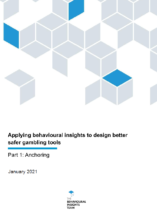Key findings
- 🚨 New report! 🚨 Can behavioural insights be used to design better tools to help people who gamble to control their spending? Commissioned by @gambleaware, we ran a field trial with customers of a major UK online gambling operator. Tweet
- Approx 1 in 5 British people gamble online regularly, with around 23m active online gambling accounts being held by 7m people. 🎰 Roughly 2m Britons experience some form of gambling harm. Tweet
- Deposit limit tools that allow people to cap their gambling spend may “anchor” ⚓ people to set higher limits. With simple behavioural tweaks, customers set limits that were almost 50% lower, potentially reducing their risk of financial harm. Tweet
Great Britain is the world’s biggest regulated gambling market. Of those who gamble, a small but significant proportion are considered ‘at risk’ of developing severe gambling issues, and some meet a clinical threshold of ‘problem gambling’. In 2017, BIT was commissioned by GambleAware to explore whether behavioural science could reduce risky gambling.
Deposit limits are one type of safer gambling tool and are used to cap the amount of money that someone is able to deposit. To set a limit, customers are typically required to scroll through a dropdown menu of pre-defined options. The options usually begin with the largest limit available, which can be up to £100,000.
BIT worked with bet365 to test two variations against the business-as-usual approach: (1) deposit limits options presented with lower values, the largest being £250; and (2) deposit limits set using a free text box only.
Compared to a control group, deposit limits were 46% lower with the free text box option and 45% lower with lower deposit suggestions. We also found that on average, an individual deposited less money into their account over 30 days under the two interventions compared to a control group. However, these latter results were not statistically significant.






